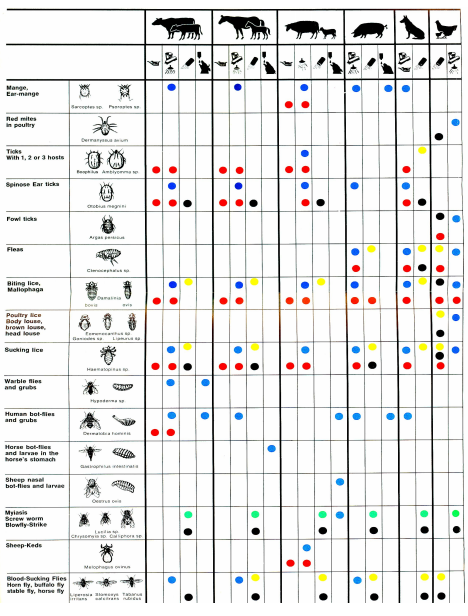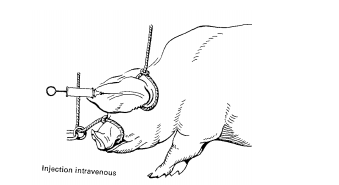The choice of drug and route of administration are determined by a number of factors namely; the disease afflicting the patient, the species, breed, size, temperament, manageability, etc. Different routes can be used for administering drugs, depending largely upon the disease condition, acuteness of the disease and general condition of the animal.
Routes of Administration
External Application
Injuries to and diseases of the skin, eye, ear and nose.
Medicaments are applied to the skin, eye, ear and nose in the form of powders, lotions, sprays and water or oil solutions. The use of water solutions requires repeated applications (every 2 hours) while ointments act over longer periods, requiring application of smaller amounts after longer intervals. Medicaments for the eye and ear should preferably be in the form of an ointment or a water base. This method of application can be used for the local treatment of wounds, rheumatism and diseases of the skin, eye and ear. Local treatment of dogs and cats with skin wounds may often be frustrating as these animals constantly lick the wounds and can thus be poisoned by the medicaments. The local application of medicaments to dogs and cats often require constant securing, large collars around the neck or the administration of sedatives.
The medicament must be applied thinly and rubbed in well into the wound. Sprays are convenient in the sense that they dry fast and thus diminish the chances of the drug being rubbed off or washed away.
Treatment of animals for external parasites
For the treatment and control of external parasites, local application of certain substances (e.g. dipping compounds) to the skin by means of various methods, are discussed forthwith.
External Parasites (dipping)


Injections (Parental Administration) and Vaccination of Animals
This implies injecting a substance into the body of the animal. The administration thereof also requires, with a few exceptions, the cleaning of the skin (with a disinfectant) as well as the disinfection of the lid of the bottle containing the drug which is to be used. Care must be taken when working with live vaccines (e.g. vaccines against virus diseases) so as not to destroy the vaccine in the process of cleaning. Sterile needles and syringes should be used (sterilisation should preferably be done by boiling the instruments in soft water for 20-30 minutes.) The person giving the injection should possess a sound knowledge of the anatomy of the animal regarding the muscles, veins and nerves. The animal must be effectively restrained for the correct technique of administration. After the needle has been pushed into the injection-site, it is advisable to connect the syringe and draw back the plunger to ensure that the needle is correctly placed. (Withdrawal of blood into the syringe is an indication that a blood vessel has been penetrated). Where possible, a clean needle should be used for every animal to prevent transmission of diseases and germs.
Click here to view a video that explains safe and effective injection techniques.
Routes Used for Injections
|
Subcutaneous |
Here the drug or vaccine is injected under the skin. The drug is taken up slower and over a longer period, as is the case with the other routes. Irritant drugs should not be injected subcutaneously. A site is chosen where the skin is loose and thus easily pulled away from the muscle or carcass. Most of the vaccines are administered just under the skin by lifting up the skin between the thumb and forefinger and injecting the prescribed amount (usually 1 - 5 cm) in the space between the skin and muscle or rest of the body |
|
Horses, cattle, sheep and goats |
The loose skin in the region of the dewlap or breast, the side of the neck or over the shoulder is used. |
|
Pigs |
Just behind the ear. |
|
Intra-muscular |
Here the drug is injected into the muscles. A sufficiently long needle should therefore be used to penetrate into the muscle. Small volumes should be injected in any one site (not more than 20 ml per site in the case of large animals). Pain and lameness may occur when large quantities are injected at one site. Absorption of the drug is rapid due to a good blood supply to the muscle. Normally hormones and antibiotics are injected into a muscle. You must make sure that the correct muscle is used and that the needle does not enter or damage the nerves and arteries. The choice of the injection site depends upon the thickness of the muscles at that site. |
|
Horses |
Preferably in the breast muscles at the bottom of the neck, although, the neck muscles may also be used (see illustration). |
|
Cattle, sheep, goats and pigs |
The muscles of the neck, rump or buttocks are the most suitable. Piglets are injected in the neck muscles behind the ear. |
|
Poultry |
Inject into the breast muscle. |
|
Intravenous |
In this case the drug is introduced into a vein, in other words, directly into the blood. Various advantages derive from this as the drug is immediately available to the body and larger volumes and more irritant substances may be administered at one time. Drugs are usually introduced slowly, while the animal is kept under control. The technique of administration is as follows: If the jugular vein is used, place a rope around the neck just in front of the shoulder and tighten the rope. This causes the blood to accumulate in the vein, rendering it clearly visible. The needle (not connected to the syringe) is pushed through the skin with a stab-movement into the vein. If the needle entered the vein (and not into the wall of the blood vessel or the subcutaneous tissues) blood will flow freely through the needle. Fit the syringe, release the cord and inject the drug slowly. |
|
Horses, cattle |
Jugular vein. |
|
Sheep and Goats |
Vein in the ear. The technique is the same as for large animals except that the cord is placed at the base of the ear. |
|
Pigs |
Inject into the breast muscle. |
|
Dogs |
Front leg. |
|
Poultry |
Into the vein of the wing. |
Intra-Mammary
This method is used for the treatment of mastitis. Clean the teat thoroughly. The nozzle of the tube or plastic syringe (specially designed for this type of injection) is inserted into the teat canal. The contents are then squeezed into the udder, which is massaged upwards a few times. Special teat cannulas can also be used.
Click here to view a video that explains treatment of clinical mastitis.
Intra-Vaginal and Intra-Uterine
In this case the drug is introduced into the vagina or the uterus by hand. Absolute hygiene is necessary, and the hand being used in the operation, must be washed and disinfected, or a sterile glove should be worn. If it is impossible to insert the drug by hand (e.g. fluids) it should be deposited by means of a sterile tube or catheter that is used in the same manner/technique as for artificial insemination.
Rectal
This means the introduction of suppositories, tablets or liquid medicaments into the rectum, mainly for the treatment of constipation.
Complications following injections are as follows:
- Abscesses may develop at the injection-site, especially when proper hygiene has not been maintained.
- Anaphylactic shock or allergic reactions may follow the administration of certain antibiotics or biological substances e.g. antisera.
- When irritating drugs were injected into a vein but leaks into the subcutis, large areas of the skin may peel off leaving unsightly wounds.
- The use of certain vaccine (pyrogenous) substances may cause a fever.
Administration of incompatible substances may result in severe systemic reactions.
Route of application to treat the parasites.

Click here to download the Application Route Table.



